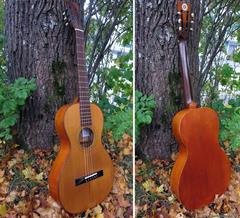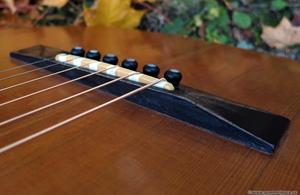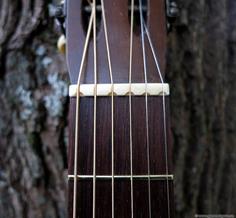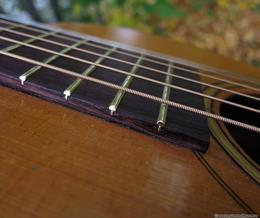Received an urgent order from none other than Andreas Brink, the man behind the Levin documentary that was shown on TV not too long ago. Nice people are allowed to go ahead, so I added it to the ongoing batch.
Since it was what I call a "half bend", a standard Levin parlor in good condition, it was quick to get it ready. Tomorrow the flashy East German will be ready and the rest of the guitars in the batch will be ready one or two a week. I hope that other customers think it's OK that this was finished first.
That said, an ordinary Levin parlor from 1908 in good condition. The tuning screws looked nice, but the spiral screw on the G string's post had received a kiss, which made it cog out. Had to look in the scrap box and found a matching tuning screw in better condition, also from a Levin of the same vintage. Andreas wanted it a little more original than usual, the stable was allowed to remain. However, the fretboard was changed from walnut to one in rosewood with a 16 ″ radius. The two bottom ribs visible through the sound holes are also the original ones. No K&K mick.
Two things were a bit special about this. On the one hand, the white printed celluloid plaque was in very good condition, and on the other hand, the alto in the neck was extremely green, except on the neck foot and head. You can think that the lacquer is dark brown on parts of the neck, but it is the wood behind the lacquer that is wood white or dark green. Maybe it is the kernel in the ales that turns green with time.
Thinned both bottom and lid to just under 3 mm for best sound. All ribs except the two originals at the bottom that are visible were replaced with my standard configuration. For the sake of rarity, I gave the inside of the bottom a round of potassium permanganate to "age" the surface so that it does not look so new through the sound hole.
The holes in the original stable were plugged and drilled up further down to make room for a stable leg. In addition, inserted a piece of ebony around the ditch for the stable leg so that it would not bring about the rotational force from the strings. The maple / birch in the Levin original stable is too soft and the stable narrow, which is why I usually make replica stables in hard wood that are a few mm wider. Failed a bit anyway at the front of the stable ditch, but it will hold.
All features were made for the best sound. Stable plate in spruce, "turbo plugs", composite stable legs and upper saddle toning. A news is that I got a thicker diamond cutter for the Dremel when I make the millings for the intonation of the upper saddle. It used to be crowded at the thick E-string, it probably got a little nicer too!
Satisfied with all the details on this. The sound was expected with all inventions in place. Sounds very good even though it's basically a simple Levin with Newtone Heritage 0.12 strings. The plugs do the trick 🙂
Got a little ribs over… here you also see the small moisture meter that I send with nowadays. The ideal is 40% moisture, but more humidity always goes well up to 80% or more as the fish glue in the bottom gluing can start to drop! Dryer than 35% should be avoided, below 30% is even dangerous 🙂
Did a sound test with the guitar. MP3 file with a little play and chords recorded with stereo capacitor mixes without applied effects about 20 cm from the sound hole. The attack comes from the plugs, the sustain from the steel plate in spruce (and the stiffness from the neck's carbon fiber rod, among other things). The pure troubadour chords come from the oversadel intonation. At the end you hear the string separation from the composite stable leg.











